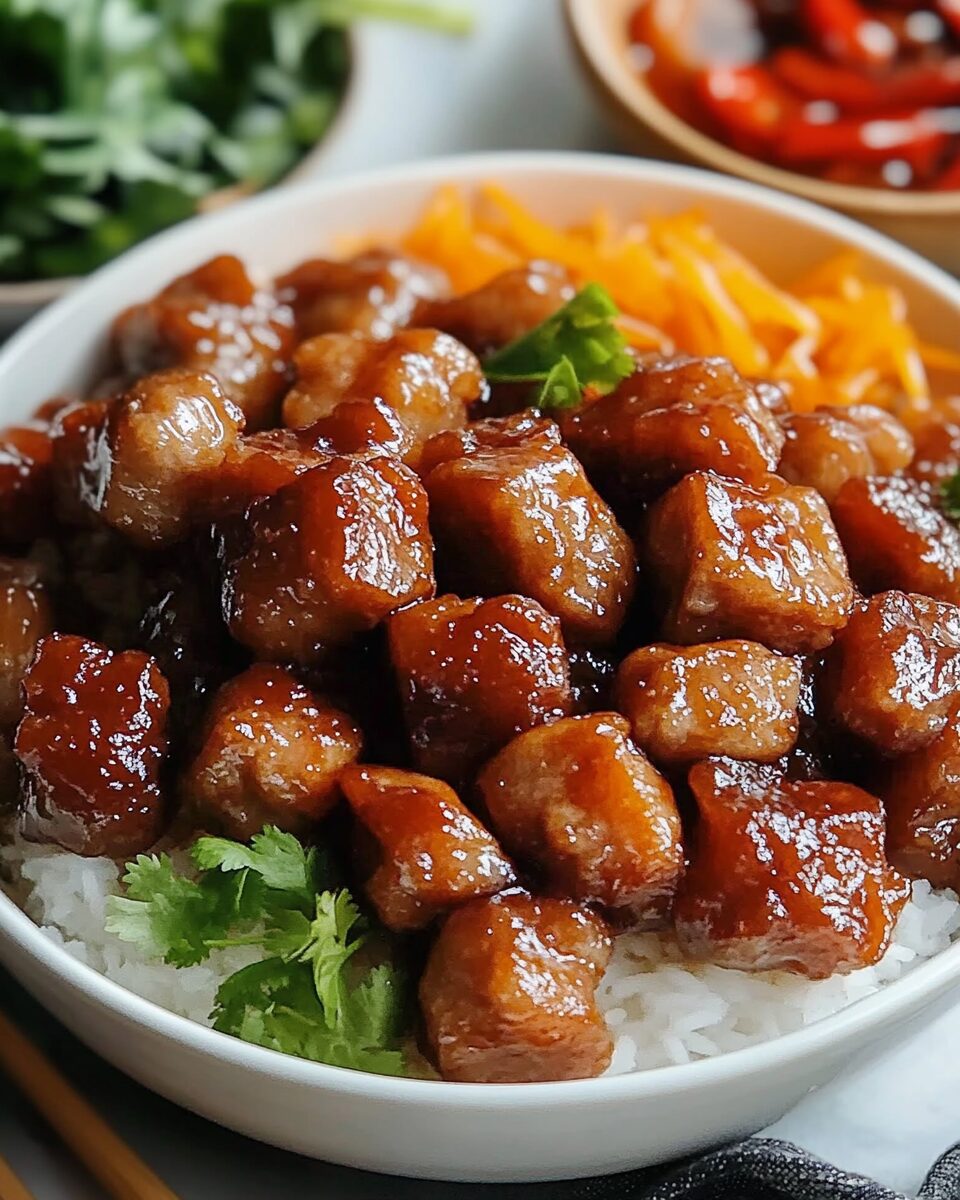Vietnamese Caramel Pork (Thịt Kho Tàu) is a comforting and flavorful dish known for its rich caramelized sauce and tender pork. A Southern Vietnamese staple, it’s often made with pork belly or shoulder, slowly braised in a blend of caramelized sugar, savory fish sauce, and fragrant aromatics. The result is a glossy, melt-in-your-mouth meal that pairs perfectly with steamed rice. Traditionally served during Lunar New Year and family dinners, this dish is simple yet packed with depth, making it a beloved part of Vietnamese cuisine.
Full Recipe:
Ingredients
-
1.5 lbs pork belly or shoulder, cut into bite-sized chunks
-
1/4 cup brown or palm sugar
-
3 tbsp fish sauce
-
1 cup coconut water
-
2 shallots, finely chopped
-
3 cloves garlic, minced
-
1 tsp black pepper
-
2 hard-boiled eggs (optional)
Directions
-
Prep the Pork: Cut pork into bite-sized pieces. Trim excess fat if using pork belly.
-
Make the Caramel: In a dry pan, heat sugar over medium heat, stirring constantly until it melts into a deep amber caramel. Remove from heat immediately to avoid burning.
-
Sauté Aromatics: Heat oil in a large pot. Add shallots and garlic, sauté until fragrant and golden.
-
Cook the Pork: Add pork to the pot and sear until lightly browned on all sides.
-
Add Sauces: Pour in the caramel, fish sauce, and black pepper. Stir to coat pork thoroughly.
-
Simmer: Add coconut water. Bring to a boil, then reduce to low heat. Cover and simmer for 45–60 minutes, stirring occasionally until pork is tender and sauce thickens.
-
Optional Eggs: Add hard-boiled eggs during the last 15 minutes to let them absorb the sauce.
-
Serve: Serve hot with steamed jasmine rice, pickled vegetables, and fresh herbs for garnish.
Nutrients
-
Calories: 400–600 kcal (varies by cut and portion)
-
Protein: 20–25g
-
Fat: 20–30g
-
Carbohydrates: 50–60g (with rice)
-
Fiber: Low unless vegetables are added
-
Sugars: Moderate due to caramel sauce
-
Sodium: High (from fish sauce)
A Slow-Braised Labor of Love
What makes Vietnamese Caramel Pork so special is the braising technique, which allows the pork to soak up the full spectrum of flavors from the sauce. The cooking process starts with creating a homemade caramel—a technique unique to Vietnamese cuisine. Unlike Western caramel that leans sweet, this version is savory with a slight bitterness that brings depth and balance. This caramel becomes the foundation of the dish’s richly colored and deeply flavored sauce.
The pork is then simmered in a mixture of fish sauce, coconut water, and aromatics like garlic and shallots. As it slowly cooks, the sauce thickens and clings to every piece of pork, infusing it with savory-sweet goodness and creating that iconic shiny glaze. The texture transforms over time—the meat becomes fork-tender, the fat luscious, and the sauce thick and syrupy.
The Flavor Profile: A Perfect Harmony
One of the most striking qualities of Thịt Kho Tàu is its depth of flavor. The sweetness from caramelized sugar and coconut water balances the bold saltiness of fish sauce, while the aromatics bring subtle complexity. Each component enhances the others, and the final dish feels both rich and light.
Unlike overly sweet caramel sauces, this one strikes a delicate balance with its bittersweet notes and savory undertones. Coconut water is a particularly important element—it adds a natural sweetness and body to the sauce without overwhelming it. The fish sauce gives the dish its umami-rich backbone, while black pepper brings just enough heat to cut through the richness of the pork.
Optional hard-boiled eggs are often simmered in the sauce near the end of the cooking time. These eggs soak up the caramelized liquid and offer a delightful textural contrast to the tender meat, making them a cherished addition in many households.
Traditional Roots and Cultural Significance
Thịt Kho Tàu is not only a culinary delight but also a dish rich in cultural symbolism. In Southern Vietnam, it’s a traditional offering during Tết (Vietnamese Lunar New Year), where it symbolizes prosperity, family unity, and new beginnings. Large pots are often made in advance and shared among extended family members, ensuring that the first few days of the New Year are spent with loved ones rather than cooking.
The dish also plays an important role in everyday Vietnamese cuisine. It’s a common comfort food, regularly served in homes across the country. Its ingredients are economical, and its preparation method encourages batch cooking—perfect for feeding large families or enjoying leftovers throughout the week.
In many households, Thịt Kho Tàu is passed down from generation to generation. Each family may have its own version: some add chili for spice, others use palm sugar for deeper sweetness, and some include lemongrass or ginger for extra fragrance. These personal touches give the dish a living legacy, connecting present-day meals with ancestral roots.
Why You’ll Love This Dish
Vietnamese Caramel Pork is a dish that appeals to a wide range of palates. It’s tender, richly flavored, and offers a harmony of tastes in every bite. The luxurious sauce is addictive and pairs beautifully with simple sides, making it a go-to dinner for both special occasions and weeknight meals.
Another reason to fall in love with this dish is its versatility. You can serve it with steamed jasmine rice, broken rice, or even sticky rice. It also pairs well with lightly pickled vegetables, which cut through the richness and add a refreshing contrast. A few sprigs of fresh herbs like cilantro or Thai basil on top provide color and a final touch of brightness.
It’s also a wonderful dish to make ahead of time. In fact, many say it tastes even better the next day as the flavors continue to meld and deepen. This makes it an ideal meal prep option and a reliable go-to for gatherings or busy weeks.
Nutritional Value and Customization
Though Thịt Kho Tàu is not a low-fat dish—especially when using pork belly—it does offer nutritional benefits, especially when balanced with vegetables and rice. Pork provides protein, B vitamins, and essential minerals like iron and zinc. Coconut water adds hydration and potassium, while garlic and shallots contribute anti-inflammatory properties.
If you’re looking to make it lighter, pork shoulder is a great alternative to pork belly, offering a leaner option without sacrificing tenderness. You can also bulk up the dish with more vegetables like carrots, daikon, or even bok choy to add fiber and freshness. Reducing the amount of sugar or switching to a more natural sweetener like coconut sugar can make it more suitable for those watching their sugar intake.
This dish is naturally gluten-free, provided your fish sauce doesn’t contain wheat (always check the label). For a paleo variation, you can omit the sugar entirely or substitute it with honey or maple syrup. Even vegans can enjoy a similar version by using tofu or mushrooms and plant-based fish sauce alternatives.
Serving Suggestions for the Perfect Meal
The classic way to serve Thịt Kho Tàu is with a generous portion of white rice, which soaks up the sticky caramel sauce beautifully. Accompany it with quick-pickled vegetables like carrots and daikon, cucumber slices, or a light Vietnamese-style salad with fish sauce dressing. The contrast of rich meat, fluffy rice, and crisp veggies creates a balanced meal that delights all the senses.
For a more elaborate spread, consider adding other Vietnamese dishes like canh chua (sour soup), gỏi (herbal salad), or chả giò (fried spring rolls). These complementary dishes can round out the flavors and textures, offering variety and satisfaction in every bite.
Leftovers store well in the fridge for several days and reheat easily in a saucepan or microwave. Many home cooks find that the second day’s flavors are even more complex and developed, making this dish a delicious make-ahead option.
Conclusion
Vietnamese Caramel Pork (Thịt Kho Tàu) is a testament to the beauty of slow cooking, thoughtful technique, and culinary tradition. With just a few everyday ingredients, this dish creates a luxurious, flavor-packed experience that comforts the soul and brings people together. Whether you’re making it for a cozy weeknight dinner or celebrating a special occasion, this dish invites you to take part in a centuries-old culinary heritage—one simmering pot at a time.
Its balance of sweet, salty, and umami flavors makes it irresistible, while the silky texture of braised pork and the rich, amber sauce keep you coming back for more. As soon as you taste it, you’ll understand why Thịt Kho Tàu is cherished in Vietnamese homes across the world. It’s not just a recipe—it’s a heartfelt tradition passed down through generations, bringing warmth, flavor, and memory to every table.






